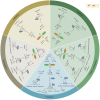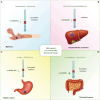Overview of the interplay between m6A methylation modification and non-coding RNA and their impact on tumor cells
- PMID: 38988908
- PMCID: PMC11231769
- DOI: 10.21037/tcr-23-2401
Overview of the interplay between m6A methylation modification and non-coding RNA and their impact on tumor cells
Abstract
N6-methyladenosine (m6A) is one of the most common internal modifications in eukaryotic RNA. The presence of m6A on transcripts can affect a series of fundamental cellular processes, including mRNA splicing, nuclear transportation, stability, and translation. The m6A modification is introduced by m6A methyltransferases (writers), removed by demethylases (erasers), and recognized by m6A-binding proteins (readers). Current research has demonstrated that m6A methylation is involved in the regulation of malignant phenotypes in tumors by controlling the expression of cancer-related genes. Non-coding RNAs (ncRNAs) are a diverse group of RNA molecules that do not encode proteins and are widely present in the human genome. This group includes microRNAs (miRNAs), long non-coding RNAs (lncRNAs), circular RNAs (circRNAs), and PIWI interaction RNAs (piRNAs). They function as oncogenes or tumor suppressors through various mechanisms, regulating the initiation and progression of cancer. Previous studies on m6A primarily focused on coding RNAs, but recent discoveries have revealed the significant regulatory role of m6A in ncRNAs. Simultaneously, ncRNAs also exert their influence by modulating the stability, splicing, translation, and other biological processes of m6A-related enzymes. The interplay between m6A and ncRNAs collectively contributes to the occurrence and progression of malignant tumors in humans. This review provides an overview of the interactions between m6A regulatory factors and ncRNAs and their impact on tumors.
Keywords: N6-methyladenosine methylation (m6A methylation); m6A regulatory factors; non-coding RNA (ncRNA); tumor.
2024 Translational Cancer Research. All rights reserved.
Conflict of interest statement
Conflicts of Interest: All authors have completed the ICMJE uniform disclosure form (available at https://tcr.amegroups.com/article/view/10.21037/tcr-23-2401/coif). The authors have no conflicts of interest to declare.
Figures





Similar articles
-
Ramifications of m6A Modification on ncRNAs in Cancer.Curr Genomics. 2024 May 31;25(3):158-170. doi: 10.2174/0113892029296712240405053201. Epub 2024 Apr 9. Curr Genomics. 2024. PMID: 39087001 Free PMC article. Review.
-
The relationship between the network of non-coding RNAs-molecular targets and N6-methyladenosine modification in tumors of urinary system.Cell Death Dis. 2024 Apr 17;15(4):275. doi: 10.1038/s41419-024-06664-z. Cell Death Dis. 2024. PMID: 38632251 Free PMC article.
-
Recent Advances in the Mutual Regulation of m6A Modification and Non-Coding RNAs in Atherosclerosis.Int J Gen Med. 2025 Feb 25;18:1047-1073. doi: 10.2147/IJGM.S508197. eCollection 2025. Int J Gen Med. 2025. PMID: 40026815 Free PMC article. Review.
-
Decoding intricate interactions between m6A modification with mRNAs and non-coding RNAs in cervical cancer: Molecular mechanisms and clinical implications.Cell Signal. 2025 Jul;131:111745. doi: 10.1016/j.cellsig.2025.111745. Epub 2025 Mar 17. Cell Signal. 2025. PMID: 40107480 Review.
-
Circular RNAs, Noncoding RNAs, and N6-methyladenosine Involved in the Development of MAFLD.Noncoding RNA. 2024 Feb 5;10(1):11. doi: 10.3390/ncrna10010011. Noncoding RNA. 2024. PMID: 38392966 Free PMC article. Review.
References
Publication types
LinkOut - more resources
Full Text Sources
